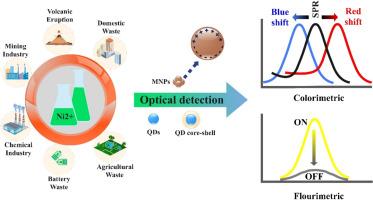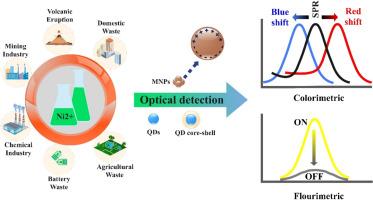Nanoparticles and quantum dots as emerging optical sensing platforms for Ni(II) detection: Recent approaches and perspectives
IF 20.3
1区 化学
Q1 CHEMISTRY, INORGANIC & NUCLEAR
引用次数: 0
Abstract
Over the preceding years, nickel (Ni) and its compounds have been increasingly employed in various aspects of human social life, metallurgical/industrial manufactures, healthcare and chemical processes. Although Ni is considered as an essential trace element in biological system, excessive intake or metabolic deficiency of Ni2+ ions may cause detrimental health effects to the living organisms. Therefore, a facile and accurate detection of Ni2+, especially in environment and biological settings, is of huge significance. As an efficient detection method, assaying Ni2+ using optical (colorimetric and/or fluorogenic) sensors has experienced quite a vigorous growth period with large number of excellent researches. Nanomaterial-based optical sensors including metal nanoparticles (MNPs), quantum dots (QDs), and carbon dots (CDs) offer distinct advantages over conventional small-molecule organic and inorganic sensors. This study mainly provides an overview of the recent advancements and challenges related to the design strategies of various optical nanosensors to selectively detect Ni2+ ion. Emphasis has also been placed on comparing the sensing performance of various nanosensors along with exploring future perspectives.


纳米粒子和量子点作为新兴的镍(II)检测光学传感平台:最新方法与前景
近年来,镍(Ni)及其化合物越来越多地应用于人类社会生活、冶金/工业制造、医疗保健和化学工艺的各个方面。虽然镍被认为是生物系统中不可或缺的微量元素,但过量摄入或代谢缺乏 Ni2+ 离子可能会对生物体的健康造成不利影响。因此,方便、准确地检测 Ni2+(尤其是在环境和生物环境中)具有重要意义。作为一种高效的检测方法,使用光学(比色法和/或荧光法)传感器检测 Ni2+ 已经经历了一个蓬勃发展的时期,出现了大量优秀的研究成果。与传统的小分子有机和无机传感器相比,基于纳米材料的光学传感器(包括金属纳米颗粒(MNPs)、量子点(QDs)和碳点(CDs))具有明显的优势。本研究主要概述了与选择性检测 Ni2+ 离子的各种光学纳米传感器的设计策略有关的最新进展和挑战。此外,还重点比较了各种纳米传感器的传感性能,并探讨了未来的发展前景。
本文章由计算机程序翻译,如有差异,请以英文原文为准。
求助全文
约1分钟内获得全文
求助全文
来源期刊

Coordination Chemistry Reviews
化学-无机化学与核化学
CiteScore
34.30
自引率
5.30%
发文量
457
审稿时长
54 days
期刊介绍:
Coordination Chemistry Reviews offers rapid publication of review articles on current and significant topics in coordination chemistry, encompassing organometallic, supramolecular, theoretical, and bioinorganic chemistry. It also covers catalysis, materials chemistry, and metal-organic frameworks from a coordination chemistry perspective. Reviews summarize recent developments or discuss specific techniques, welcoming contributions from both established and emerging researchers.
The journal releases special issues on timely subjects, including those featuring contributions from specific regions or conferences. Occasional full-length book articles are also featured. Additionally, special volumes cover annual reviews of main group chemistry, transition metal group chemistry, and organometallic chemistry. These comprehensive reviews are vital resources for those engaged in coordination chemistry, further establishing Coordination Chemistry Reviews as a hub for insightful surveys in inorganic and physical inorganic chemistry.
 求助内容:
求助内容: 应助结果提醒方式:
应助结果提醒方式:


